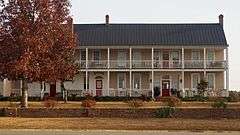Smithonia
|
Smithonia | |
 | |
| Nearest city | Comer, Georgia |
|---|---|
| Built | 1866 |
| Architect | James Monroe Smith (Georgia planter) |
| Architectural style | Plantation Plain |
| NRHP Reference # | 84001213[1] |
| Added to NRHP | June 21, 1984 |
Smithonia is a historic site in the U.S. State of Georgia. The land was part of Georgia agricultural tycoon and state legislator James Monroe Smith (Georgia planter)'s property holdings. It was built in 1866 in a "Plantation Plain" architectural style. The nearest city is Comer, Georgia but Smithonia, Georgia is now a distinct location. The Smith and Dunlap Railroad connected the property with the Georgia Railroad at Dunlap, Georgia. The rail line was also used to construct Howard's Covered Bridge.
The building was listed on the National Register of Historic Places in 1984.[1]
James M. Smith held hundreds of debt slaves on a farm that stretched thirty miles from the town he named after himself: In the post-Civil War economy, Smith nurtured a small farm into the state's largest plantation. He became a major buyer of convicts soon after Georgia's Reconstruction government was toppled by a campaign of voter fraud and Ku Klux Klan violence. For workers he relied on an army of terrified convict slaves, including many African Americans he had owned before the war or their descendants.
If workers tried to flee, Smith relied on deputy sheriffs to recapture them and his own overseers to inflict brutal punishments. "They had dogs to trail them with so they always got caught, and then the whipping boss beat them almost to death," John Hill said. "It was awful to hear them hollering and begging for mercy. If they hollered 'Lord have mercy!' Marse Jim didn't hear them, but if they cried, "Marse Jim have mercy!' then he made them stop the beating. He say, 'The Lord rule Heaven, but Jim Smith ruled the earth.'"[2]
See also
References
- 1 2 National Park Service (2009-03-13). "National Register Information System". National Register of Historic Places. National Park Service.
- ↑ Blackmon, D. A. (2008). Slavery By Another Name, New York: Anchor Books.